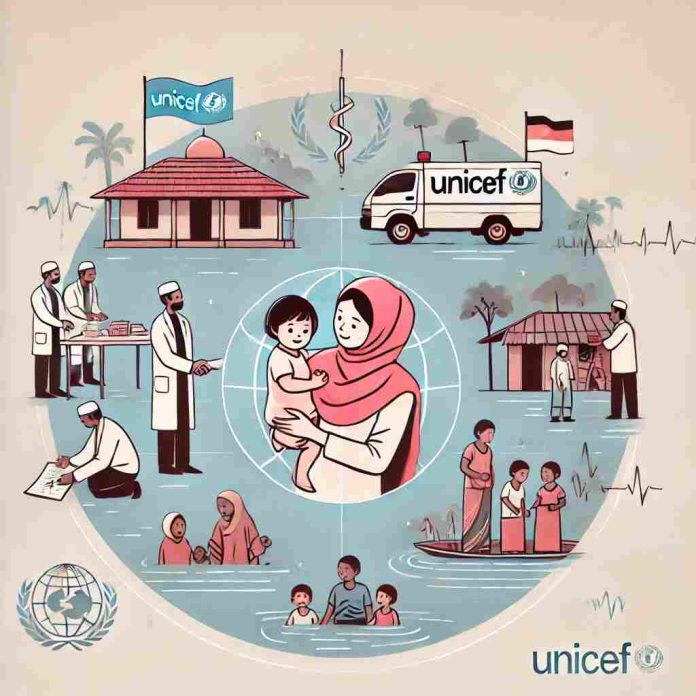South Asia, one of the most densely populated regions in the world, is currently facing several humanitarian crises. A recent UNICEF report highlights the grave challenges faced by children and families in the region. In this article, we will discuss the key points of the report, UNICEF’s response, and steps being taken to improve the region.
Overview of the Humanitarian Crisis in South Asia
The state of the humanitarian crisis in South Asia is extremely worrying.
Population pressure: The region has a population of over 1.8 billion, a large portion of which faces poverty, hunger, and health problems.
Conflict and instability: Political instability and conflict in many countries have worsened the humanitarian situation. For example, the ongoing conflict in Afghanistan has displaced millions of people.
Key challenges
The UNICEF Humanitarian Situation report mentions the following key challenges:
Health crisis:
Malnutrition: The rate of malnutrition among children in South Asia is very high. According to the report, about 50 million children are malnourished, which poses a serious threat to their growth and health.
Disease outbreaks: Disease outbreaks such as dengue, measles, and polio are increasing in the region, further worsening the health condition of children.
Barriers to education:
School closures: School closures due to the COVID-19 pandemic have severely affected children’s education. Millions of children are out of school, especially girls.
Quality of Education: Lack of resources in schools and a lack of trained teachers are also affecting the quality of education.
Climate Change and Natural Disasters:
Floods and Droughts: Floods, droughts, and other natural disasters in South Asia are creating serious challenges for children and families. These disasters not only affect lives but also disrupt education and health services.
UNICEF Response
UNICEF has taken several important steps to address these challenges:
Emergency Aid Programs:
UNICEF has provided immediate aid in crisis areas, including food aid, medical services, and resources for education.
Temporary Education Centers: UNICEF has set up temporary education centers, where children can receive education in a safe environment.
Health Programs:
UNICEF has promoted vaccination programs, which help protect children from diseases.
Nutrition Programs: UNICEF has launched special nutrition programs to combat malnutrition, which provide children with the necessary nutrition.
Climate Change Awareness:
UNICEF is running awareness programs to reduce the effects of climate change, thereby preparing communities for natural disasters.
Collaboration and Partnerships
UNICEF has worked closely with local and international organizations:
Collaboration with Local Organizations: UNICEF has partnered with local NGOs and community organizations to speed up aid delivery.
Government Collaboration: UNICEF has worked with various governments to help implement policies that protect children’s rights.
Future Plans
UNICEF’s future plans include the following:
Long-Term Education Programs:
UNICEF has planned long-term education programs that focus on providing quality education to children.
Girls’ Education: Programs are being developed to promote girls’ education in particular, so that they can return to school.
Expansion of Health Services:
UNICEF will launch new programs to enhance health services, including mental health services.
Immunization Campaign: UNICEF will further strengthen vaccination programs, so that all children can get the necessary vaccines.
Related Information
For more information about other programs and reports of UNICEF, you can visit the official website of UNICEF.
Other Humanitarian Situation Reports: You can know about other programs and initiatives going on in South Asia by reading other humanitarian situation reports released by UNICEF.
Thus, UNICEF’s Humanitarian Situation Report in South Asia not only highlights current challenges, but it also informs the steps being taken to improve the region. A better future for children and families
Conclusion
The UNICEF report highlights the gravity of the humanitarian situation in South Asia.
Solutions to the Crisis: The steps taken by UNICEF and future plans are crucial towards a better future for children and families in the region.
Everyone’s Responsibility : It is essential that all stakeholders, including governments, NGOs, and communities, work together to protect the rights of children and provide them with a safe and healthy life .
Also Read: UNICEF Young leaders initiative: Protecting children rights and empowering their voice

